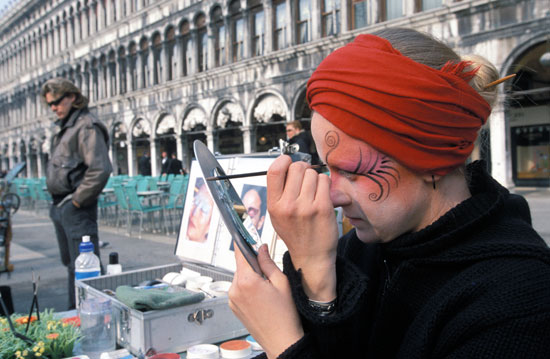The candid approach to photographing people is certainly worthwhile, but has limitations. Furtive behaviour will surely arouse suspicion but candid work does not have to be undertaken surreptitiously. When conducted openly, perhaps at a large open-air event, is likely to be more acceptable. However, attitudes are not the same all over the world. Curiously, as societies develop so people seem to need and trust each other less. It is the experience of many photographers that it is easier to earn trust in less-developed parts of the world than in the West, but mistakes can be made anywhere. In any case, don't expect every subject to share your enthusiasm. A few people may protest if they realize what you are doing, but most do not object to a camera used with sensitivity. This is where your cultural and social judgement comes into play. Consider, in an appropriate local context, how those around you will view your activities. Then plan accordingly.
 Should you choose to close in on a subject the requirement to get involved will increase. The closer you go, the greater the involvement. Many photographers admit to shying away for this reason. Try to see situations from the subject's point of view and remember that pointing a camera at a stranger may be regarded as rude or intrusive. Even those who enjoy the attention may soon lose interest. Gain experience with sitting ducks - buskers, street traders and performers, market folk and so on. Have the courage of your convictions and go for it, but retain a degree of sensitivity and don't expect universal acceptance. With experience you will develop a feel for who might enjoy or tolerate your attention. A helper can reduce the self-consciousness of the subject by distracting attention and keeping conversation flowing, but two people cause greater disruption than one. Don't persist if things feel wrong. Vulnerable people living on the streets, alcoholics, prostitutes and various other groups may with some justification be suspicious of your motives. In such situations it is easy to get your camera smashed.
Should you choose to close in on a subject the requirement to get involved will increase. The closer you go, the greater the involvement. Many photographers admit to shying away for this reason. Try to see situations from the subject's point of view and remember that pointing a camera at a stranger may be regarded as rude or intrusive. Even those who enjoy the attention may soon lose interest. Gain experience with sitting ducks - buskers, street traders and performers, market folk and so on. Have the courage of your convictions and go for it, but retain a degree of sensitivity and don't expect universal acceptance. With experience you will develop a feel for who might enjoy or tolerate your attention. A helper can reduce the self-consciousness of the subject by distracting attention and keeping conversation flowing, but two people cause greater disruption than one. Don't persist if things feel wrong. Vulnerable people living on the streets, alcoholics, prostitutes and various other groups may with some justification be suspicious of your motives. In such situations it is easy to get your camera smashed.
Initial sensitivity can be demonstrated by the simple courtesy of asking permission before photographing someone. If you don't speak the local language, use a gesture. If permission is refused it is better not to persist - how would you like it? Otherwise try to get involved in conversation. This breaks down barriers and encourages understanding on both sides. Openness and humility are usually appreciated and returned. Show an interest in your subject's activity and offer a smile or a cigarette - but not money. It changes attitudes and kills communication. Demonstrate that you are human, and that you have a sense of humour. Show your feelings and encourage emotional responses. Laugh at yourself and at preposterous situations. Aim to find some common ground or experience. Appealing to children is often a winner when approaching parents.
Even in today's fast-moving and cynical world there is a great deal of good in the majority of folk. Human warmth and compassion penetrate every social and cultural barrier. Give the best of yourself and some of it will be reflected. Be polite, take your time, say thank you and know when to leave.






